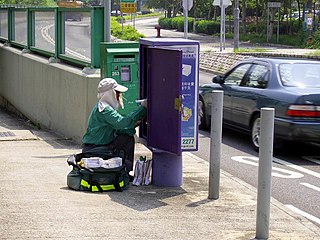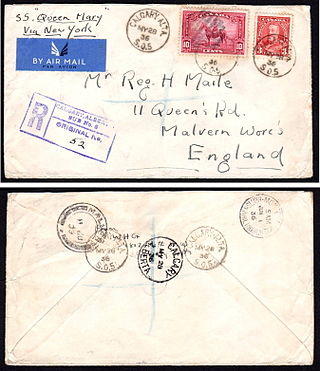
The mail or post is a system for physically transporting postcards, letters, and parcels. A postal service can be private or public, though many governments place restrictions on private systems. Since the mid-19th century, national postal systems have generally been established as a government monopoly, with a fee on the article prepaid. Proof of payment is usually in the form of an adhesive postage stamp, but a postage meter is also used for bulk mailing.

A postcard or post card is a piece of thick paper or thin cardboard, typically rectangular, intended for writing and mailing without an envelope. Non-rectangular shapes may also be used but are rare. There are novelty exceptions, such as wooden postcards, copper postcards sold in the Copper Country of the U.S. state of Michigan, and coconut "postcards" from tropical islands.

A Christmas card is a greeting card sent as part of the traditional celebration of Christmas in order to convey between people a range of sentiments related to Christmastide and the holiday season. Christmas cards are usually exchanged during the weeks preceding Christmas Day by many people in Western society and in Asia. The traditional greeting reads "wishing you a Merry Christmas and a Happy New Year". There are innumerable variations on this greeting, many cards expressing more religious sentiment, or containing a poem, prayer, Christmas song lyrics or Biblical verse; others focus on the general holiday season with an all-inclusive "Season's greetings". The first modern Christmas card was by John Calcott Horsley.
An E-card is an electronic postcard or greeting card, with the primary difference being that it is created using digital media instead of paper or other traditional materials. E-cards are made available many different ways, usually on various Internet sites. They can be sent to a recipient virtually, usually via e-mail or an instant messaging service.

Postal service in the United States began with the delivery of stampless letters whose cost was borne by the receiving person, later encompassed pre-paid letters carried by private mail carriers and provisional post offices, and culminated in a system of universal prepayment that required all letters to bear nationally issued adhesive postage stamps.

Postal history is the study of postal systems and how they operate and, or, the study of the use of postage stamps and covers and associated postal artifacts illustrating historical episodes in the development of postal systems. The term is attributed to Robson Lowe, a professional philatelist, stamp dealer and stamp auctioneer, who made the first organised study of the subject in the 1930s and described philatelists as "students of science", but postal historians as "students of humanity". More precisely, philatelists describe postal history as the study of rates, routes, markings, and means.

Registered mail is a mail service offered by postal services in many countries which allows the sender proof of mailing via a mailing receipt and, upon request, electronic verification that an article was delivered or that a delivery attempt was made. Depending on the country, additional services may also be available, such as:

A greeting card is a piece of card stock, usually with an illustration or photo, made of high quality paper featuring an expression of friendship or other sentiment. Although greeting cards are usually given on special occasions such as birthdays, Christmas or other holidays, such as Halloween, they are also sent to convey thanks or express other feelings.

A Christmas stamp is a postage stamp with a Christmas theme, intended for use on seasonal mail such as Christmas cards. Many countries of the world issue such stamps, which are regular postage stamps and are usually valid for postage year-round. They usually go on sale some time between early October and early December, and are printed in considerable quantities.

The system for mail delivery in the United States has developed with the nation. Rates were based on the distance between sender and receiver in the early years of the nation. In the middle of the 19th century, rates stabilized to one price regardless of distance. Rates were relatively unchanged until 1968, when the price was increased every few years by a small amount. Comparing the increases with a price index, the price of a first class stamp has been steady. The logo for the Post Office showed a man on a running horse, even as the railroads and then motorized trucks moved mail. In 1970, the Post Office became the Postal Service, with rates set by the Postal Regulatory Commission, and some oversight by the Congress. Air mail became standard in 1975. In the 21st century, prices were segmented to match the sorting machinery in use; letters too large for the machines required slightly higher postage.

Mid-century modern (MCM) is a design movement in interior, product, graphic design, architecture, and urban development that was popular in the United States and Europe from roughly 1945 to 1969, during the United States's post–World War II period. The term was used descriptively as early as the mid-1950s and was defined as a design movement by Cara Greenberg in her 1984 book Mid-Century Modern: Furniture of the 1950s. It is now recognized by scholars and museums worldwide as a significant design movement. The MCM design aesthetic is modern in style and construction, aligned with the Modernist movement of the period. It is typically characterized by clean, simple lines and honest use of materials, and it generally does not include decorative embellishments.

Freepost is a postal service provided by various postal administrations, whereby a person sends mail without affixing postage, and the recipient pays the postage when collecting the mail. Freepost differs from self-addressed stamped envelopes, courtesy reply mail, and metered reply mail in that the recipient of the freepost pays only for those items that are actually received, rather than for all that are distributed. Freepost of preprinted cards issued by businesses is also different from postal stationery sold by postal administrations.

Deltiology is the study and collection of postcards. The word was first coined by Professor Randall Rhoades of Ashland, Ohio, in 1945. However, it took about twenty years for it to first appear in a dictionary. Compared to philately, the identification of a postcard's place and time of production can often be an impossible task because postcards, unlike stamps, are produced in a decentralised, unregulated manner. For this reason, some collectors choose to limit their acquisitions to cards by specific artists and publishers, or by time and location.

U.S. Special Delivery was a postal service paid for with additional postage for urgent letters and postal packets which are delivered in less time than by standard or first class mail service. Its meaning is different and separate from express mail delivery service. Essentially it meant that a postal packet was delivered from a post office to the addressee immediately once it arrived at the post office responsible for delivering it, rather than waiting for the next regular delivery to the addressee.

Curt Otto Teich was an American publisher of German descent who produced popular color postcards, primarily of scenes from American life. He was a pioneer of the offset printing process. Under his management, the Curt Teich & Company became the world's largest printer of view and advertising postcards.

The 1930 Graf Zeppelin stamps were a set of three airmail postage stamps, each depicting the image of the Graf Zeppelin, issued by the United States Post Office Department in 1930, exclusively for delivery of mail carried aboard that airship. Although the stamps were valid for postage on mail sent on the Zeppelin Pan American flight from Germany to the United States, via Brazil, the set was marketed to collectors and was largely intended to promote the route. 93.5% of the revenue generated by the sale of these stamps went to the Zeppelin Airship Works in Germany. The Graf Zepplin stamps were issued as a gesture of goodwill toward Germany. The three stamps were used briefly and then withdrawn from sale. The remainder of the stock was destroyed by the Post Office Department. Due to the high cost of the stamps during the Great Depression, most collectors and the general public could not afford them. Consequently, only about 227,000 of the stamps were sold, just 7% of the total printed, making them relatively scarce and prized by collectors.
Stanley A. Piltz was an American photographer and publisher of Mid-Century Modern graphic design and printed ephemera. Stanley A. Piltz Company, San Francisco, issued many Linen Type postcards from the 1930s to the 1950s, depicting scenes of California, especially of the San Francisco Bay Area and the 1939 Golden Gate International Exposition. They consisted primarily of scenic views, city, town, civil and military infrastructures and national monuments views. Linen Type postcards were produced on paper with a high rag content which gave the postcard a fabric type look and feel. At the time this was an inexpensive process. Along with advances in printing technique, linen type cards allowed for vibrant ink colors. Stanley Piltz pioneered the Linen Type postcards with his "Pictorial Wonderland Art Tone Series".

Burton Frasher was an American photographer and publisher of mid-century modern ephemera. His black-and-white landscape photographs of the American West have been widely reproduced.
The Rust Craft Greeting Card Company was an American greeting card, printing company and owner of television stations.

Tichnor Brothers, Inc. was a Boston-based American graphic arts and printing company in operation from 1908 to 1987. Tichnor was one of the major producers of souvenir postcards of American cities in the 20th century, including large-letter postcards from 1936 to 1952. Tichnor and Curt Teich were rivals; in at least one case Curt Teich managers wanted to copy a view from a Tichnor postcard. The Tichnor Bros. archives, a valuable source for American architectural and cultural history, are held at Boston Public Library, which has also posted thousands of free-use images online at their Digital Commonwealth site and in Flickr albums.

















